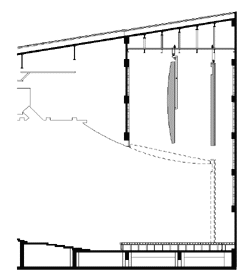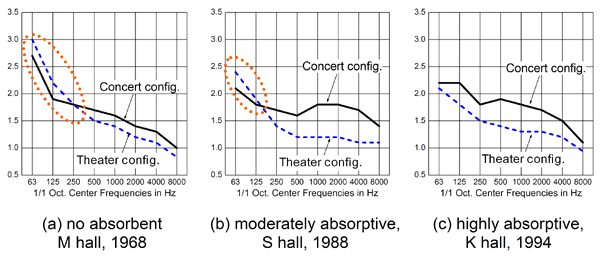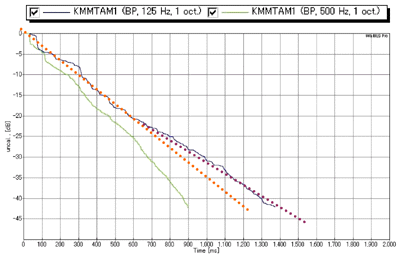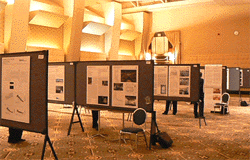
Title means "Quietness", "Comfortable Sound" and "Excellent Acoustics"
Nagata Acoustics News 06-09 (No.225)
Issued :September 25, 2006
"Coupled Room" Acoustics - the Stage, Fly Tower, and Hall Connection
by Dr. Keiji Oguchi
Fig.1 Typical multi-purpose hall
 |
At the 9th Western Pacific Acoustics Conference (WESPAC IX), held June 25 - 28, in Seoul, Korea, I was invited to present at a session on room acoustics entitled "Acoustics in coupled volumes " The term "coupled room (volume)" refers to two adjacent spaces that share an aperture defined by certain size parameters. When the two spaces that comprise a coupled room have considerably disparate size or different sound absorption characteristics, a known acoustical phenomenon occurs of a change in the reverberation sound decay curve of the primary room or chamber to slower decay (depicted on a graph as a more gradual decay slope). The aim of the "Acoustics in coupled volumes" session was to reconsider and deepen our understanding of this phenomenon.
In Japan, where many multipurpose halls have been constructed, the majority of these facilities have stages with tall fly towers and the stages connect to audience seating areas via proscenium openings. This design exemplifies the definition of a coupled room, with the audience seating area being the primary space, the fly tower the secondary space, and the proscenium opening the aperture. The WESPAC invitation requested that I discuss room acoustical design for this kind of coupled room. To prepare for my presentation, I retraced the development of Japanese acoustical design methodologies involving hall reverberation time and specifications for fly tower interior treatments. In the paragraphs below, I will share my findings on this topic.
<< Sound Absorption in Multipurpose Hall Fly Towers >>
Because the walls of a fly tower protrude upward above the facility's roof line, the exterior walls of the fly tower are in direct contact with outside air temperature and, therefore, building design specifications place thermal insulation material along the fly tower interior walls. Some thermal insulation materials used for this purpose also exhibit sound absorption characteristics. Nevertheless, in Nagata Acoustics' projects, for the interior walls of fly towers, we recommend applying interior wall finishing materials that have the specific purpose of obtaining a desired level of sound absorption performance. The reason for our approach is to control the reverberation produced inside the tall fly tower above the stage.
In multipurpose halls, the stage can basically be adapted to two kinds of configurations. One configuration spreads the panels of an orchestra shell on the stage to turn the separate stage and audience seating areas into a single, unified space for concert performances. The second kind of configuration has the orchestra shell housed out-of-sight in the fly tower space, and a main stage curtain and other stage equipments are set or descended for the hall's use as a theater. If the fly tower interior has minimal or no sound absorptive properties, then the measured reverberation time in the audience seating area will be longer, especially for lower frequencies, when the hall is configured as a theater than when it is configured as a concert hall.
Fig.2 Reverberation time in multi-purpose hall for
different acoustical finishing in fly tower
 |
Fig.3 Double decay curve without
absorptive material in fly tower
 |
When a multipurpose hall is configured for concert use, the panels of the orchestra shell vibrate slightly causing them to absorb some low frequency sound energy. When the same hall is configured for theater use, the orchestra shell are stored away, the sound is exposed to stage curtains that have negligible low-frequency sound absorptive properties, and the sound travels into the fly tower where, rather than decaying, the low frequencies instead become lengthened. The lengthened low frequencies sound reverberate back into the hall's audience seating area producing a longer reverberation for these frequencies when the hall is configured as a theater. Charted on a graph, the double decays are found on the reverberation curve.
<< Use of Sound Absorbing Materials in Japanese Halls' Fly Towers >>
While Nagata Acoustics now routinely considers and generally recommends the addition of sound absorbing material to interior fly tower walls, in preparing my presentation, I became curious to learn when this practice became standard in Japan. I researched the archives of Japanese acoustical conference papers that focused on the estimation of reverberation times in multipurpose halls.
In 1964, architect Tohru Funakoshi, working with the firm Nikken Sekkei, proposed that, because the projected reverberation time of multipurpose hall concert configurations closely match their actual measured reverberation times, multipurpose hall designers should begin by calculating the concert configuration reverberation time, then multiply the values by a conversion coefficient to obtain the expected reverberation time for the same hall's theater configuration. Already in this report, the author mentions a "reverse reverberation decay phenomenon" for low frequency sound and the double decay reverberation curve. The 1964 Funakoshi report states, "The sound energy that enters the tall fly tower section reflects off the interior wall, which has a sound reflecting finish. The repeated reflection of the sound energy results in a lengthening of the reverberation time." Based on this report, I conclude that in this era, sound absorptive material was not yet being added to the fly towers of Japanese multipurpose halls.
More than a decade later, in 1979, Yamamoto and Ogawa, of NHK Technical Research Laboratories, authored a report on sound absorptive characteristics of materials used in the acoustical design of halls in which they propose a method for estimating the reverberation time of a multipurpose hall's theater configuration. The method suggests that a virtual surface can be posited at the orchestra shell also for the theater configuration. The virtual surface can be assigned sound absorption coefficients and the reverberation time for the theater configuration can be calculated as follows: "With the exception of halls that have fly towers not treated to be absorptive, we think that a good value to use for the virtual surface's sound absorption of mid-to-upper-range frequencies is 0.6 - 0.65." By the time this report was written, the use of absorptive finishing for interior fly tower walls had become prevalent.
>From the texts of these two reports on Japanese multipurpose halls, we can understand that the addition of sound absorptive treatments to the interior walls of fly towers began after the mid-1960s, and the purpose of adding the sound absorptive materials in fly towers was to control the reverberations created in the tall fly tower spaces of multipurpose hall stages. Incidentally, the method of estimating theater configurations' reverberation times using the sound absorption coefficients of a virtual surface has the benefit of eliminating the need to re-estimate the room volume and surface area when estimating the theater configuration's reverberation time. The method is an efficient approach from the perspective of day-to-day acoustical engineering design work, and is a technique currently used by professionals at Nagata Acoustics.
<< Pros and Cons of Adding Sound Absorbing Material to a Fly Tower >>
Interestingly, outside of Japan, hall and theater fly tower interiors rarely have sound absorbing materials. Even when a fly tower of a hall or theater outside of Japan does have sound absorbing material, invariably it has been applied selectively in the fly tower, not along the entire interior walls. In addition, some Japanese halls constructed before the mid-1960s, and therefore without sound absorbing material in their fly towers, continue to serve as performance venues in Japan today.
Tokyo Bunka Kaikan is one such hall. The fly tower walls contain no sound absorbing materials and some people attribute the hall's well-known rich acoustics partially to the absence of sound absorbing material in the fly tower. Since the hall's opening in 1961, Tokyo Bunka Kaikan has undergone a number of renovations, the most recent of which completed in 1999 (see our News & Opinions issue on Bunka Kaikan) and included reconstruction of the fly tower, yet the fly tower continues to remain bare of sound absorbing material.
A recent variation on installing sound absorbing material in fly tower interior walls places the material inside the fly tower but leaves a gap between the fly tower wall and the sound absorbing material. The aim of this design is improved control over low frequency reverberations. Surely, this design eliminates the phenomenon of double reverberation decay of low frequencies. However, this writer questions the assumption that the longer decay tail of low frequencies, depicted in graphs, is never appropriate or desirable. As long as music or speech is running in the hall, listeners do not consciously notice the longer decay tail of the low frequencies, and, except in extreme cases that would appear like an extended tail in the decay curve graph, the phenomenon does not produce any sense of artificiality. Given our ability to control the phenomenon, I wish to give further consideration to whether and when the best desired state is to absorb the reverberation produced in fly towers.
Listening to Classical Music with 5.1 Multi-channel Equipment
by Hideo Nakamura
The movie industry introduced 4-channel surround sound audio systems in the 1980s and thereafter, various products came to market as the technology developed until the current consensus on the 5.1 multi-channel recommendation of the International Telecommunications Union (ITU) became generally accepted. Increasingly, DVDs produced for the consumer market include 5.1 multi-channel audio, and Japan's electronics retailers entice customers to purchase 5.1 multi-channel home theater systems by prominently playing demonstration videos on the latest hardware with 5.1 multi-channel reproduction functionality. Surely, surround sound has contributed tremendously to the overall experience of many movie productions, so much so that when a movie appears without surround sound, the trend is to judge it as somehow lacking.
Recently, we see the use of 5.1 multi-channel audio expanding beyond movie theaters and DVDs to use with High Definition Television (HDTV) as an add-on benefit of HDTV broadcasts. For example, when the 2006 New Year concert of the Vienna Philharmonic was broadcast in Japan via live satellite transmission, it was broadcast using 5.1 multi-channel audio, a novel coupling of surround sound technology with TV that remains fresh in my memory. Until this broadcast, surround sound was a technology of interest to movie and video fans. Now we see the TV networks promoting adoption of surround sound technology to the classical music audience.
How Japan's classical music fans will receive 5.1 multi-channel audio as a medium for classical music is a fascinating question. At present, I expect that the vast majority of Japanese classical music fans have not experienced listening to classical music reproduced by a 5.1 multi-channel audio system. Like other Japanese consumers, when this writer passes by a store that sells surround sound equipment, I see demo content focused exclusively on movies. Since there is no opportunity in current Japanese retail settings to leisurely listen to a surround sound system playing classical music content and assess the system's value, I had not felt like having one myself yet.
Some days ago, I had the fortuitous opportunity to participate in a demonstration of a surround-sound-reproduced classical music concert under ideal conditions. In the remainder of this article, I will share my experience and resulting thoughts on surround sound audio with our readers.
<< Listening to Classical Music Reproduced with 5.1 Multi-channel Audio >>
The surround sound demonstration I attended was held in a hall-like studio with several dozen fixed seats and large-size loudspeakers impeccably arranged in the most advantageous locations. The content was an orchestral concert recorded for television broadcast use, with the visual material projected onto a screen at the front of the studio and the orchestra's performance heard through the loudspeakers.
If I limit my comments to the audio experience, the sound matched the rich resonance I hear when seated in a concert hall. Furthermore, the artificiality of having the sound emanate from loudspeakers gave me less of a feeling of discomfort than I would have expected, and instead, seemed quite natural. As the television station's press release information suggests, combining HDTV with this technology for classical music enjoyment undoubtedly has the potential to captivate consumers of the future.
<< Will Japanese Classical Music Fans Want Surround Sound? >>
Now, if I ask myself whether this new classical music broadcast offering will appeal to all of Japan's classical music fans, I would be doubtful about answering in the affirmative. While surround sound creates a hall-like, spatial acoustical experience that is unachievable using stereo equipment, if the listener wants to focus on the sound nuances and fine details of a musical performance, some classical music fans are likely to argue that surround sound is a hindrance rather than a benefit.
The most likely result of the introduction of surround sound offerings to the Japanese classical music market will be a division of the market into one faction that lauds surround sound and another faction that will oppose it. In this vein, the people who attended the surround sound demonstration with me also divided into two camps of opinion after experiencing the demonstration. The likelihood of divided opinions on surround sound by the target audience of classical music fans makes for a major difference compared to the reception of surround sound by movie fans. In addition, the ability of movies' surround sound effects to add enjoyment value may be very tolerant of the range of equipment, performance levels and set-up conditions in consumer households. By contrast, I expect that the evaluation of classical music reproduced by surround sound equipment will be subject to stricter standards in terms of listening environment, set-up specifications and equipment quality.
<< Suggestions for Classical Music Surround Sound's Next Steps >>
Based on my recent initial experience listening to classical music via surround sound equipment, the classical music community should be provided concrete information about the goals and benefits of adding surround sound to classical music broadcasting, because there are diversity of musical tastes, listening styles, and broadcast quality expectations of them. Since most of the listening public will continue to listen to classical music broadcasts using 2-channel stereo equipment, we should ensure that the move to provide multi-channel broadcasting does not negatively affect the sound quality for listeners using 2-channel stereo equipment. Surround sound should remain an optional, value-added benefit that, I hope, will not lead us to neglect efforts to further improve the quality of stereo broadcasting.
The 151st Meeting of the Acoustical Society of America (ASA) in Providence
by Akira Ono
Poster Session
 |
The 151st Meeting of the Acoustical Society of America (ASA) took place in Providence, Rhode Island, from June 5 to 9, 2006. Providence is the capital of the United States' smallest state, Rhode Island, and is situated between Boston and New York.
Providence has a population of 170,000 and is home to Brown University and a number of design schools. It is a calm, New England college town with a waterfront on upper Narragansett Bay. The 151st Meeting of the ASA was held at the centrally located Rhode Island Convention Center.
<< Poster Session with "Houses of Worship" Theme >>
At this year's meeting, the theme of the Architectural Acoustics poster session focused on "Spaces of Worship - Another Quarter Century of Experience (1984 - Present)" and included poster presentations of Christian churches, chapels and cathedrals, as well as of Islamic mosques. A similarly themed poster session was held in 1983, at the 106th Meeting of the ASA.
Since the ASA meeting is a U.S. organization, most of the poster participants were from the United States. Nevertheless, 60 worship facilities in various countries were presented. Nagata Acoustics presented posters on Reinanzaka Church, Tokyo Church of Christ, Shinanomachi Church, Catholic Hatsudai Church and St. Margaret's Chapel, for a total of five poster presentations.
In addition to poster presentations of newly constructed houses of worship, the presentations included projects to improve the clarity of amplified sound at historical houses of worship, such as a Saudi Arabian mosque and at a cathedral, as well as at immense megachurches and similar worship facilities of other faiths. The poster presentations on megachurches gave me the impression that most of these facilities are planned primarily as venues for worship in the format of musical performances.
<< The "Celebration: 50 Years of Speech Privacy" Session >>
A highlight event of the meeting was a full day program organized by the ASA/INCE Joint TC-AA.NS.SC Subcommittee on Speech Privacy, which included papers delivered by 10 invited acoustical engineering professionals. The papers' topics ranged from discussions of the current body of knowledge related to methodologies, strategies and conditions for evaluating the results of surveys and data obtained at businesses with open office floor plans and at hospitals, to discussions of the increasing need for high levels of speech security capabilities, a topic reflective of current events and the ethos of our time.
The Speech Privacy Session began with Prof. Leo Beranek taking the podium. He shared the history of this sub-discipline, from the pioneering achievements of Bolt, Beranek, Newman & Cavanaugh in 1955 to the present day. In addition to this introduction, Dr. Beranek presented an additional paper during this session. Dr. Beranek, who is now well past his 90th year, continues to work and speak with vitality, and I was strongly impressed to be in his presence and learn from him.
<< "Acoustics of Libraries" Session >>
I also attended the Acoustics of Libraries session, at which six papers were delivered. The session was characterized by lively presentations and discussions about acoustics at school libraries of the future, a topic not discussed at acoustical meetings in Japan. One presentation by the research group at a university reported on an approach to the school library that divided the facility's rooms into three types. One kind of room is designated as quiet space, another for computer use, and a third kind is designated for conversation. Separate acoustical plans were created for the three kinds of rooms. The presentation, which was accompanied by acoustical measurement data, described the resulting facility as efficient and comfortable, as well as a stimulating environment for highly productive student use.
E-mail Distribution of Nagata Acoustics News & Opinions
We hope you have enjoyed this News & Opinions newsletter, available each month on our web-site (http://www.nagata.co.jp). We also offer e-mail delivery of the text version of this newsletter. To receive the text newsletter to your e-mail address, simply send the following information to us at newsmail_e@nagata.co.jp:
(1) Your e-mail address
(2) Your name
(3) The name of your company
By requesting the text version via e-mail, you will automatically receive every newsletter and you can still get the visuals and graphics at our web-site.
Nagata Acoustics News 06-09 (No.225)
Issued : September 25, 2006
Nagata Acoustics Inc.
Hongo Segawa Bldg. 3F, 2-35-10
Hongo, Bunkyo-ku, Tokyo 113-0033 Japan
Tel: +81-3-5800-2671, Fax: +81-3-5800-2672
(US Office)
2130 Sawtelle Blvd., Suite 307A,
Los Angeles, CA 90025, U.S.A.
Telephone: (310) 231-7818
Fax: (310) 231-7816
E-mail: info@nagata.co.jp






